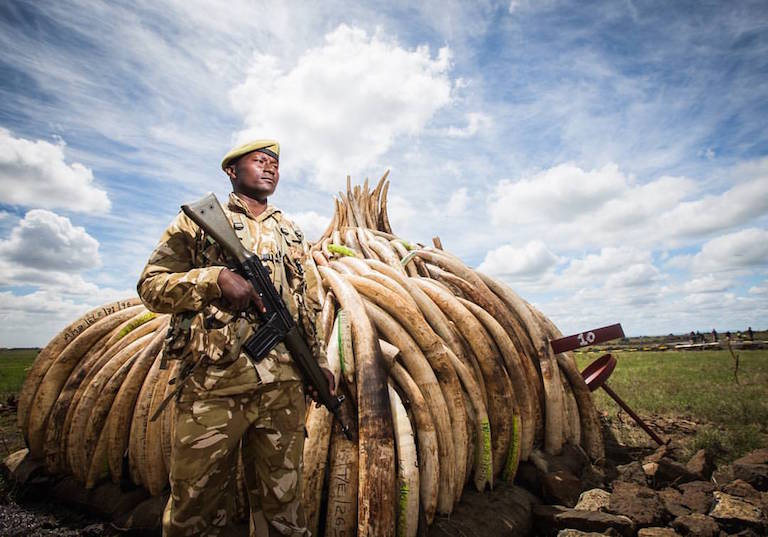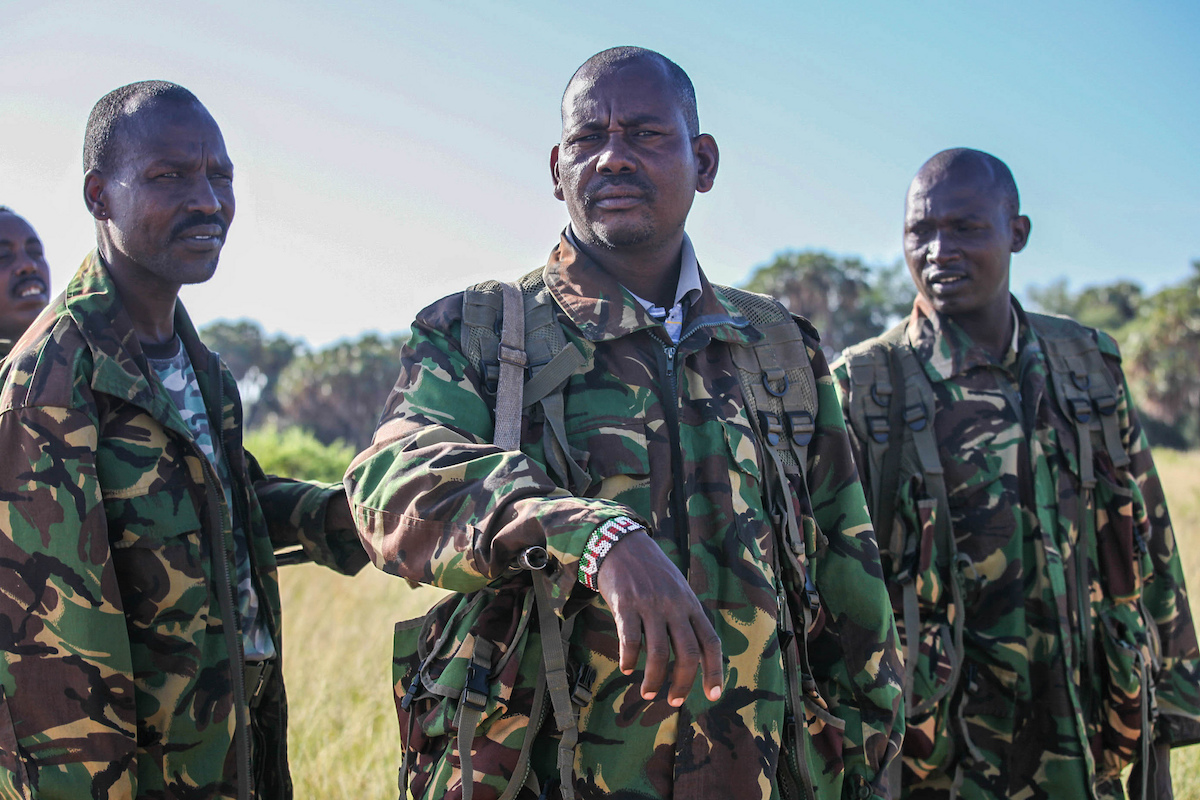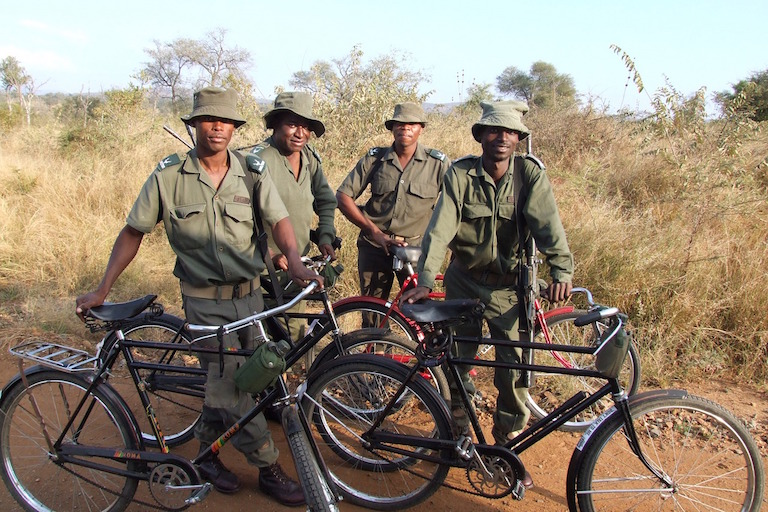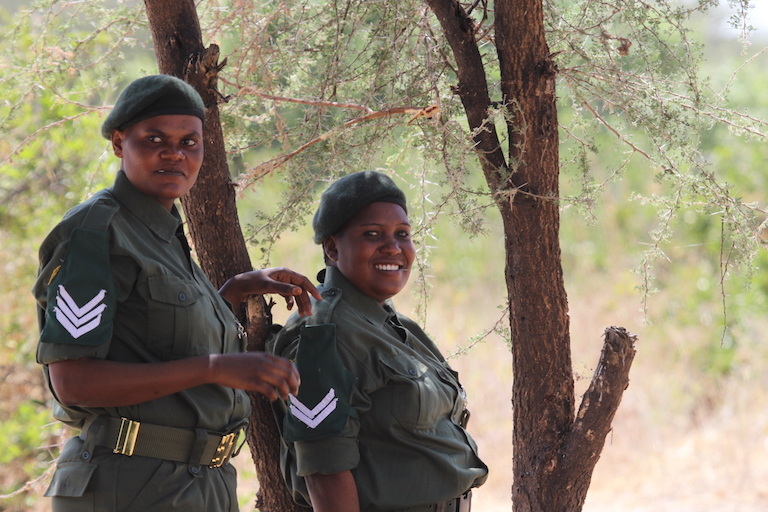- Due to skyrocketing consumer demand, particularly from Asia, today’s wildlife traffickers have the resources to outfit their henchmen with weaponry and equipment that often outmatches that of the local park rangers.
- The poachers doing the most damage in Africa today are employed by professional trafficking syndicates, and they enjoy a level of support and financial backing unimaginable during earlier poaching crises.
- The poachers’ arsenal includes the expanding use of military-grade equipment like helicopters, machine guns, infrared scopes, and heavy armored vehicles.
On January 29, a 37-year-old Englishman and ardent conservationist named Roger Gower was piloting a helicopter over Tanzania’s Maswa Game Reserve when he spotted the corpse. With safari guide Nick Bester at his side, Gower, who worked for the nongovernmental Friedkin Conservation Fund, slowly circled the hacked and bloody elephant carcass below. Rangers on the ground had alerted them that gunfire had been heard the previous day, and here was the awful result. The men couldn’t see the poachers, but the dead elephant’s tusks were still intact; they were likely still nearby.
As the men hovered over the body, their copter was abruptly rattled by explosive bursts of automatic gunfire from the canopy below. One round came through the floor and tore through Gower’s leg and shoulder before piercing the ceiling. Fatally injured, Gower somehow managed to land the copter before dying, allowing Bester to escape into the bush. Nine suspects were later arrested and four were charged with murder. The rest were reportedly charged with economic sabotage and unlawful possession of firearms; four have received prison sentences up to 20 years.
Roger Gower is only one of the more visible casualties of a recent upsurge in violence caused by the illegal wildlife trade. Dozens of African rangers are killed each year by increasingly well-armed and -organized poachers in a bloody conflict over the continent’s wildlife. The escalation includes the expanding use of military-grade equipment like helicopters, machine guns, infrared scopes, and heavy armored vehicles by poachers who are wiping out Africa’s remaining megafauna for the Asian black market.

The Thin Green Line Foundation, an Australia-based NGO that provides support for the families of rangers killed on the job, reports that worldwide, “it’s estimated that over 1,000 park rangers have been killed in the line of duty over the past 10 years, 75% by commercial poachers and armed militia groups. Park rangers are generally under-equipped, underpaid, and often under-appreciated.”
Meanwhile, in May the World Wildlife Fund (WWF) released a survey of 570 rangers across 12 African countries highlighting their difficult working conditions. According to the survey, 82 percent of respondents have faced life-threatening situations, 59 percent believe they are ill equipped for their jobs, 42 percent believe they are inadequately trained, 75 percent have been threatened, and 77 percent see their families for 10 days or less per month.

A new business model
What’s happening in Africa today isn’t like the earlier poaching crisis of the 1980s, when mainly destitute poachers were often armed with antiquated bolt-action rifles unequipped with scopes for long-range shots. Due to skyrocketing consumer demand, both from an Asian market eager for everything from ivory to pangolin scales and a thriving domestic African trade in bushmeat, today’s wildlife traffickers have the resources to outfit their henchmen with weaponry and equipment that often outmatches that of the local park rangers.
Rhino horn now rivals gold for value, sometimes reaching approximately $65,000 to $75,000 per kilogram on the black market, while international criminal trafficking in terrestrial wildlife amounts to as much as $10 billion annually. The money to be made motivates the extremes of violence and the growing sophistication of arms and equipment employed by poaching networks, and each dead rhino or elephant increases the worth of the survivors, as in any fading commodity.
This new breed of poacher is armed with military-grade weaponry, often acquired through criminal syndicates taking advantage of the political and social chaos in places like Libya, the Central African Republic, Nigeria, Mali, and Somalia. Terrorist groups like the Lord’s Resistance Army in central Africa often fund their gruesome activities through poaching, and even corrupted national military units have actively participated in wildlife crime.
The Armed Forces of the Democratic Republic of the Congo “have been identified by independent observers as among the most ruthless ivory poachers in the DRC, where the state military is reportedly responsible for 75 per cent of all poaching in nine of 11 investigated areas with elephant populations in the country,” states a 2015 report by the Geneva-based, multi-government-funded Small Arms Survey organization.
The result is that ecological gems like Kruger National Park in South Africa have been reduced into virtual warzones. Kruger’s 20,000-square kilometers is home to the great majority of Africa’s remaining rhinos, and it shares a porous border with Mozambique, where governmental corruption and economic incompetence have created conditions of desperate poverty that form an ideal breeding ground for wildlife crime. Last year Kruger lost 1,175 rhinos to poachers, many of whom were Mozambicans. The park’s rangers, now by necessity trained in military tactics, killed approximately 500 poachers between 2011 and 2015, nearly all from Mozambique.

“We are fighting a war,” Johan Jooste, a former army general and now chief commander of anti-poaching efforts for South African National Parks, told Africa Geographic in 2014. Such is the intensity of the war for rhino horn that it has effectively superceded his other duties. “For now my job is all about Kruger and its rhino” Jooste said in the interview. “These rhinos in Kruger are the most valuable cache of environmental assets in the world. Rhino horn is more valuable than gold or platinum. Gram for gram, its the most expensive commodity on the planet. Throughout Africa, rangers are performing military roles to battle poachers. We have to militarize our ranger corps. This problem will not go away.”
South African law prohibits rangers from initiating deadly force, so they are forced to attempt arrests of poachers, which takes time and resources that other poachers use to their advantage. With only around 500 rangers under Jooste’s command, a park as enormous as Kruger can be effectively patrolled only in tiny segments at a time.
Many of Kruger’s poachers are not simply poor people desperate for money to survive on; they’re often career criminals, skilled in outdoor survival techniques and the handling of heavy weapons. “As much as I despise them,” said Jooste, “the poachers can survive well in the bush, and their bushcraft is remarkable. Their tracking is good, and their resilience is of note. They are a formidable opponent with no rules.”
The poachers doing the most damage in Africa today are employed by professional trafficking syndicates, and they enjoy a level of support and financial backing unimaginable during earlier poaching crises.
“We must not forget,” warned Jooste, “that what we are dealing with here is international organized crime, backed up by foreign criminals. These syndicates are so wealthy that they could be a Fortune 500 company on their own. They don’t have any conscience, laws or rules and they have good intelligence, and they have unlimited resources. So they will help poachers out, there will be bail and then legal defense.”
A lack of support
The fighting is taking place nearly everywhere on the continent that wildlife habitat still exists. Another major battlefield is the chaotic Democratic Republic of the Congo (DRC). In April, elephant poachers killed three rangers and wounded two others in Garamba National Park; poachers killed five rangers and three army troops in the same park last year. And in the country’s besieged great ape bastion of Virunga National Park, 150 rangers have been slain by militia seeking revenue from wildlife, charcoal, and other natural resources in the last decade alone. The park is the continent’s oldest and home to one quarter of the world’s remaining mountain gorillas (Gorilla beringei beringei). “We cannot sustain these kind of losses in what is still the most dangerous conservation job in the world,” park head Emmanuel de Mérode — himself shot and wounded by militia in 2014 — told The Guardian this spring.
Being a ranger in Africa is not only extremely difficult and hazardous, as the WWF survey made clear; usually it is also unrewarding, with rangers in Kenya and Tanzania said to be making as little as $50 to $60 a month. And when rangers are killed, their families are often left destitute.

“Governments in Africa give little pensions to the families of murdered rangers,” Peter Fearnhead, co-founder of the nonprofit African Parks, told Equal Times in January. “Funeral costs can overwhelm families; health needs spiral and the dreams of rangers’ children are shattered. Rangers families live in constant fear for the future.”
African Parks rehabilitates and fully manages parks under contract with governments that often lack the resources to capably conduct anti-poaching efforts themselves. The group currently manages ten parks totaling 6 million hectares in seven countries. It pays the widows of rangers slain in parks it manages the equivalent of six years’ salary, a strong commitment given the paltry benefits most African governments extend to their rangers.
Groups like African Parks, rangers in places like Virunga, and individuals like Johan Jooste stand in stark contrast to the corruption, incompetence, and lack of professionalism that too often plague African wildlife management agencies. The New York Times reported that one of the arrestees in Roger Gower’s murder was “a former police officer who used his current position as an intelligence officer with a regional conservation authority to help the poachers travel undetected.” Low pay makes rangers particularly susceptible to bribery by flush poaching syndicates. By one estimate, around half of East Africa’s rangers are corrupt, The Guardian reported.
But even well managed programs place enormous strain on the modern African park ranger and his or her family. Lawrence Munro described the constant state of danger his work has placed him and his young family in to the website Traveller 24 last year. At the time, Munro was director of the Rhino Operations Unit for the South African province of KwaZulu-Natal, which abuts Kruger; he has since joined African Parks.
“I am thinking combatively all the time,” he said. “My family and I have had very directed, pointed death threats. Letters addressed to me that say: we don’t want you around anymore.”
Munro said he is constantly armed and on guard, and his family is afraid to travel after dark without him acting as armed escort. He said he works strenuously long hours, carefully mapping out the locations of suspected poachers by day and hunting them down at night. Munro said he feels forced to keep much of his work secret, even to his own family, almost as if he were a secret agent. “It’s such a great feeling to catch a rhino poacher or middleman,” Munro said. “But the job does take its toll.”

And this is South Africa, the continent’s richest and (until recently, at least) most well governed country. The danger posed by poachers makes daily life in poorer countries even worse for their rangers, and in some places authorities even contend that it threatens the very fabric of society.
“Wildlife crime has become a serious threat to the sovereignty and the stability of some of our countries,” said Ali Bongo Ondimba, president of Gabon, in a 2014 press statement put out by the International Union for the Conservation of Nature. “Poachers do not hesitate to fire upon our park rangers. In some countries they are involved in a bush war as intense as any modern conflict.”

Bright spot
In spite of the extreme challenges there are some bright spots. One is the PAMS Foundation Tanzania, an NGO based in Arusha that monitors and protects elephant and giraffe populations and works with tribal communities to resolve human-wildlife conflict.
Max Jenes, PAMS’s Ruvuma Elephant Project Coordinator, joined the group in 2011. He told Mongabay he signed up “despite being intimidated and warned by my close friends … as I was going to work in a tough and risky environment.”
To combat criminal syndicates that have come to dominate the illegal wildlife trade in the area, Jenes implemented a program to recruit promising young men from the area as rangers, improve his team’s professionalism, and perfect their tactics. His approach relies heavily on gathering intelligence from local informants, asking for police support when required, and judiciously deploying rangers to patrol identified wildlife hotspots. And he said it resulted in a poaching decline of 93 percent over a three-year period in his area of operation.
“The very important secret of success in anti-poaching is to create a good relationship with the community surrounding the reserve or park,” Jenes said. “Good relationships assist with recruitment of honest informants who are the vital ingredient for successful anti-poacher patrols.”

Solid intelligence and the direct involvement of local communities in efforts to predict and disrupt poaching before it happens are common ingredients among successful anti-poaching efforts. Another is the sheer determination and dedication of many rangers against difficult odds and heavy weaponry.
One of Max Jenes’s most promising teammates is James Nchimbi, who started his career with a passion for wildlife and a desire to become a ranger, but no money for school. After a great deal of persistence, he finally managed to get a scholarship to attend Pasiansi Wildlife Training Institute in the northwestern city of Mwanza, he told Mongabay.
Not long after graduation, in 2012, Nchimbi said he had his first taste of the brutal realities of war in the bush when he led a team of rangers in a midnight ambush of four armed poachers. After four minutes of fighting, the poachers fled — fortunately for Nchimbi’s unit, as well as the poachers themselves. But danger is never far away, and Nchimbi said two rangers were recently killed in the area where he works.
Nevertheless the pride of fulfilling a duty that comes from the heart continues to animate people like James Nchimbi, who said he continually encourages local young men to pursue careers as rangers. “I love to encourage young committed people to join us in conservation, especially in the anti-poaching operations,” he said.
In many places, men like Jenes and Nchimbi are all there is to ensure that their children and grandchildren, and yours and mine too, will inherit a world that still thunders under dusty elephant stampedes, that resonates with the lions’ tectonic roar, and that is still capable of offering us at least an evanescent glimpse of the sublime world of beauty and terror from which we all sprang.
| CORRECTION 9/13/16: A previous version of this story stated incorrectly that the NGO African Parks offers three years’ salary to family members in the event of a ranger’s death; in fact the group offers six years’ salary. It also gave an outdated description of Lawrence Munro’s professional affiliation. The current version has been updated to correct these errors, which we regret. |
